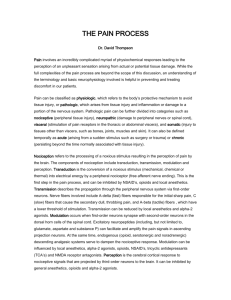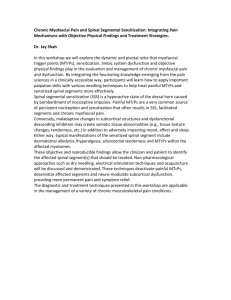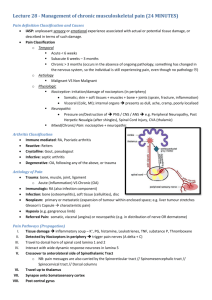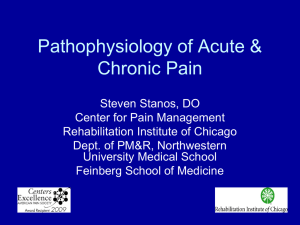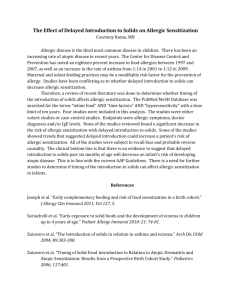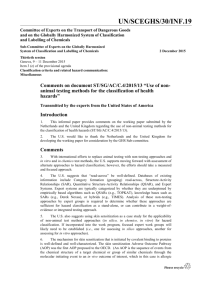Central sensitization
advertisement
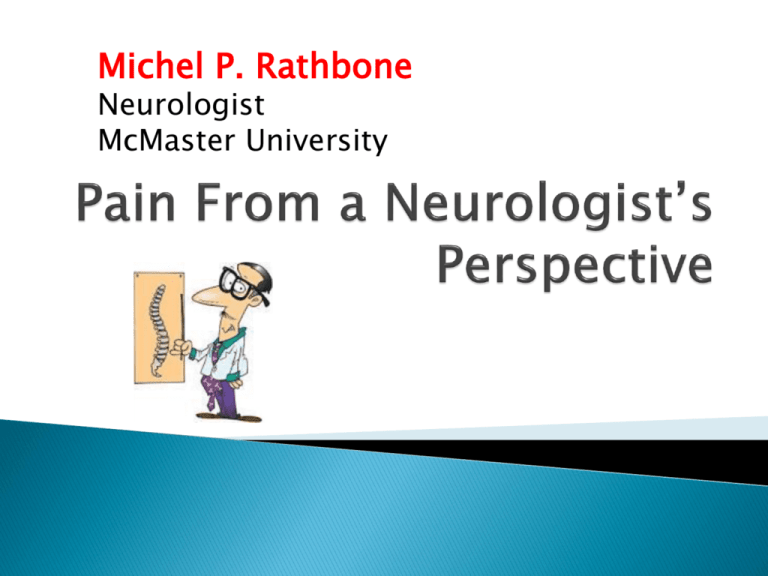
Michel P. Rathbone Neurologist McMaster University Definition Anatomy of pain Types of pain - neuropathic and nocioceptive Chronic pain – epidemiology Sensitization – peripheral and central Imaging Pain and mental status - cognition Pain -“An unpleasant sensory and emotional experience associated with actual or potential tissue damage, or described in terms of such damage” International Association for the Study of Pain There is a new realization that chronic pain is a disease of the brain Neuropathic Nociceptive However, in clinical practice, there is usually the combination of these types of pain in a patient with chronic pain Pain initiated as a direct consequence of a lesion or disease affecting the somatosensory system No physiological advantage (warning) Causes suffering and distress Characteristics include burning, paresthesias, painful cold, electric shocks, itchiness, and can be associated with numbness Allodynia (painful response to non painful stimuli) and/or hyperalgesia (increased response to painful stimuli) Neuropathic pain Pain initiated or caused by a primary lesion or dysfunction in the nervous system Peripheral neuropathic pain Pain initiated or caused by a primary lesion or dysfunction in the peripheral nervous system Central neuropathic pain Pain initiated or caused by a primary lesion or dysfunction in the central nervous system Spinal cord injury – central neuropathic pain Cervical or lumbar radiculopathies Brachial plexus injuries Peripheral nerve injuries (median, ulnar, radial, peroneal nerves) Phantom Limb pain (after amputation) Complex Regional Pain Syndrome (CRPS) Brain infarction (especially in the thalamus and brainstem)/traumatic brain injury Fibromyalgia (?) An appropriate physiological response transmitted to a conscious level Nociceptors activated in any body tissue Organism warned of tissue damage Coordinated reflexes and behavioral responses Low back pain is the most common complaint and can arise from degenerative changes in the spine aggravated by changes in gait and posture. Low back pain Headaches Spasticity e.g. in brain and spinal cord injured patients Whiplash injuries Fractured/sprained/strained joint (ankle, shoulder, wrist) Arthritis Fibromyalgia (?) It is estimated that about 15% to 29% of Canadians suffer from chronic pain (Boulanger, 2007). About one million patients in Canada have neuropathic pain (Moulin, 2002) Definition: Increased responsiveness of nociceptive neurons to their normal input, and/or recruitment of a response to normally subthreshold inputs. Peripheral sensitization: Increased responsiveness and reduced threshold of nociceptive neurons in the periphery to the stimulation of their receptive fields. Central sensitization: Increased responsiveness of nociceptive neurons in the central nervous system to their normal or subthreshold afferent input IASP, 2012 Pain Pathophysiology Peripheral Sensitization Leads to Central Sensitization 1. Local trauma Thalamus 2. Release of kinins from injury site 3. Area of Primary Hyperalgesia HI S BK IL Pain Pathophysiology Peripheral Sensitization Leads to Central Sensitization 4. Antidromic release of peptides from axon collaterals => FLARE, WHEAL Thalamus PERIPHERAL SENSITIZATION 5. Zone of secondary hyperalgesia mediated by SP, Glu, CGRP CGRP SP Gl u SP Gl u CGRP Pain Pathophysiology Peripheral Sensitization Leads to Central Sensitization 6. Increased nociceptive input from the periphery Thalamus 7. Wind up of dorsal horn neurons CENTRAL SENSITIZATION CGRP SP Gl u SP Gl u CGRP Lee et al, 2011 Headache/migraine Fibromyalgia Chronic low back pain Whiplash Associated Disorders Osteoarthritis Rheumatoid Arthritis Studies looking at mechanical stimuli for chronic whiplash and central sensitization: Deep tissue stimulation: pressure algometry Skin and nerve tissue stimulation: light touch, pinwheel, vibration, Brachial Plexus Provocation test Thermal stimulation: heat, cold Electrical stimuli: EMG, transcutaneal electrical stimulation Local anesthetic use does not impact central sensitization, but facet blocks help, suggesting nociceptive input arise from the zygapophyseal joint. The coexistence of sensory hypersensitivity and hypoaesthesia in chronic WAD indicates that both central facilitatory and inhibitory processes are affected in these patients (VanOsterwijck, 2013) 14 whiplash patients and 14 healthy controls were given painful stimuli (single electrical stimulus intramuscular, repeated electrical stimulation both intramuscular and transcutaneous, and heat) and thresholds were measured at the neck and lower limb. All patients in the whiplash group had significantly lower pain threshold for all painful stimuli except for heat. The authors found a hypersensitivity to peripheral stimulation in whiplash patients. Hypersensitivity was seen after cutaneous and muscular stimulation both at the neck and lower limb. Because hypersensitivity was observed in healthy tissues, it resulted from alterations in the central processing of sensory stimuli (central hypersensitivity). Use of local anesthetic did not influence pain thresholds or hypersensitivity at the neck and the lower limb sites in response to single and repeated intramuscular and transcutaneous electrical stimulation, and it did not influence neck pain intensity. These results suggest generalized hypersensitivity was not dependent on nociceptive input arising from the painful and tender muscles. Central hypersensitivity was not dependent on a nociceptive input arising from the painful and tender muscles. Neuro-immunological involvement A cascade of events are proposed following an injury within the central nervous system at the cellular level. Cells (glia, neurons) become activated and produce and release cytokines leading to further activation and release of pain mediators. Glial or neuronal pro-inflammatory cytokines can sensitize peripheral nociceptive fields and dorsal root ganglia. Cytokines and growth factors have been associated in the involvement of generating pathological pain states throughout the nervous system – especially proinflammatory cytokines like IL-1, IL-6, and TNF, which are upregulated both at the local site of injury and in the spinal cord in persistent pain. Immune activation with cytokine production may indirectly induce pain mediators such as glutamate, nitric oxide, and prostaglandins in the CNS, leading to further spinal sensitization. Neuroinflammation occurs in which immune cells migrate from the periphery to the CNS in association with pain; leading to further changes in the CNS and potentially to central sensitization. These infiltrating immune cells contribute to neuronal activation and algesic mediator release, further perpetuating the maintained excitability and sensitization in the CNS which leads to behavioral sensitivity and pain. Winkelstein et al, 2004) Proposed relationship between mechanical injury (e.g. musculoskeketal disorder) and nociceptive physiological responses. Winkelstein et al, 2014) Sava et al., 2009, Mol Pain The central areas in the brain associated with central sensitization include the thalamus, amygdala, insula cortex, supplementary motor cortex, posterior parietal cortex, prefrontal cortex, anterior cingulate cortex, periaquedutal gray, basal ganglia, cerebellar cortex, and the primary and secondary sensory cortex. (May, 2011) Lee et al (2007) Brainstem activity contributed to the maintenance of the CS state Activity in the somatosensory cortex reflected the perceptual consequence of CS, that is an increase in the intensity of pain experienced Results of mixed-effects analysis of the average group response for controls and patients in response to cold and punctuate stimuli. Figure one is all areas affected by pain. Red – primary somatosensory cortex; Light blue – secondary somatosensory cortex; Dark blue – anterior cingulate cortex; Green - insula a. Patients vs. Controls b. High PainDETECT vs. Low PainDETECT Chronic pain has been associated with poorer performance in various cognitive functions. Tamburin et al (2014) found patients with chronic low back pain had poorer decision making performance and cognitive flexibility skills compared to healthy controls. Compared to controls, chronic pain patients took longer to complete tests of sustained attention and mental flexibility (Oosterman et al, 2012). Reduction in psychomotor speed (Sjogren, 2004) Neurocognitive Test Performances In Chronic Pain Patients. William Parkinson PhD, Yasir Rehman MD, Michel Rathbone MD, Mohit Bhandari MD, Shucui Jiang PhD, Dinesh Kumbhare MD, Jonathan Adachi. Background & Purpose: Chronic pain is likely to be associated with weaknesses, relative to control groups, in at least some cognitive functions including processing speed, attention, and possibly working memory, but differences between studies obscure the size of effects. This study provided a quantitative analysis of the magnitude of the association between chronic pain and neurocognitive test performances. Methods: Meta-analysis was performed using the Cochrane, PRISMA guidelines. Conclusions: 1. Chronic pain was associated with Effect Sizes of 1/3 to close to a full SD poorer performance. 2. Correlates of chronic pain were non-specific, with relative weaknesses in tests requiring speed, working memory, learning, executive functions, and a range of attention abilities. 3. More research is needed to test non-verbal abilities, executive functions, and to control for estimated pre-morbid IQ. Definition Types of pain - neuropathic and nocioceptive Chronic pain – epidemiology Sensitization – peripheral and central Imaging Pain and mental status – cognition Research studies vs. Individuals Most treatments for CS should target the brain (mainly pharmacological) Pain neuroscience education and cognitive behavioral therapy targeting cognitive and emotional sensitization. Dry needling Transcranial magnetic stimulation Melatonin Cervical radiofrequency neurotomy for cervical facet joint pain (whiplash patients) Targeting metabolic factors – low carbohydrate or ketogenic diet to diminish hyperexcitability of the CNS. Manual therapy (Sterling et al, 2010) Exercise therapy – activates endogenous analgesia, and has been shown to reduce fMRI changes (Micalos et al, 2014) As most chronic pain conditions involve central sensitization, treatment strategies need to be able to desensitize the CNS. Most conditions require a multimodal analgesic approach to include pharmacotherapy, cognitive-information processing therapies, and rehabilitation. Medication . . TCAs SSRIs SNRIs Alpha adrenergic agents Opioids Tramadol Descending Inhibitory Pathways (NE/5HT, opioid receptors) Central Sensitization Peripheral Sensitization Na+ CBZ OXC TCA TPM LTG Lidocaine Spinal Cord Ca++: GBP LVT OXC LTG PREGAB NMDA: Ketamine Dextromethorphan Methadone Memantine TCA: Tricyclic antidepressant, SSRI: Selective serotonin reuptake inhibitor, SNRI: Serotonin and norepinephrine reuptake inhibitor, CBZ: Carbamazepine, OXC: Oxcarbazepine, TPM: Topiramate, LTG: Lamotrigine; GBP: Gabapentin; LVT: Levetiracetam; PREGAB: Pregabalin;. Adapted from Beydoun A., Backonja M.M; Mechanistic stratification of antineuralgic agents. Journal of Pain and Symptom Management, 2003:25:5S (p.S27) with permission from the U.S. Cancer Pain Relief Committee
